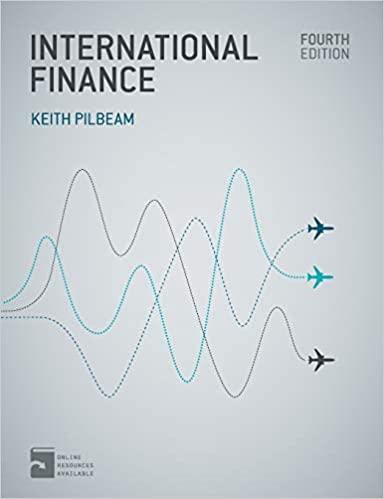Question
1. As a stockholder in Randolph Corporation, you receive its annual report. In the financial statements, Randolph has reported that the after-tax (net) income is
1. As a stockholder in Randolph Corporation, you receive its annual report. In the financial statements, Randolph has reported that the after-tax (net) income is $300 million. With 150 million shares of common stock outstanding, Randolph announced to distribute $100 million of dividends to its shareholders. The stock is now sold for $20 per share.
a. Assume that Randolph Corporation does not have any outstanding debt. The current share price reflects the fair value of the Corporation.
i. Find the market value of Randolph Corporation before the ex-dividend date,
ii. Find the market value of Randolph Corporation after the ex-dividend date,
iii. Find the price per share of Randolph Corporation after the ex-dividend date,
iv. Calculate the value of investors wealth who holds 4,000 shares of Randolph Corporation before the ex-dividend date,
v. Calculate the dividend income of an investor who holds 4,000 shares of Randolph Corporation until the ex-dividend date,
vi. Calculate the value of shareholding on the ex-dividend date of an investor who holds 4,000 shares of Randolph Corporation.
b. Based on your answers in part C to answer the following question. Does it matter for the investor to sell his shares before the ex-dividend date or to hold his shares until the ex-dividend date which enables him to receive dividend? Assume the dividend is paid on the ex-dividend date.
2. You are considering the purchase of a stock that is currently selling at $64 per share. You expect the stock to pay $4.5 in dividends next year. a. If dividends are expected to grow at a constant rate of 3 percent per year, what is your expected rate of return on this stock? b. If dividends are expected to grow at a constant rate of 5 percent per year, what is your expected rate of return on this stock? c. What do your answers to part (a) and part (b) indicate about the impact of dividend growth rates on expected rate of returns on stocks? vvv3. You are considering the purchase of a stock that is currently selling at $64 per share. You expect the stock to pay $4.5 in dividends next year. a. If dividends are expected to grow at a constant rate of 3 percent per year, what is your expected rate of return on this stock? b. If dividends are expected to grow at a constant rate of 5 percent per year, what is your expected rate of return on this stock? c. What do your answers to part (a) and part (b) indicate about the impact of dividend growth rates on expected rate of returns on stocks?
3. How do corporate stocks differ from bonds? Explain.
4. Icy Candy announces a 1 for 8 bonus issues. Icing Candy shares are trading at $9.00 before the bonus issue. a. Calculate the theoretical price of Icing Candys shares immediately after the bonus issue. b. Casper has 1,000 shares in Icy Candy before Icing Candy announced the 1 for 8 bonus issue. i. How many bonus shares will Casper entitle to? ii. Find the value of Caspers stockholding in Icy Candy before and after the bonus issue.
5. Eason plans to open a do-it-yourself dog bathing center in Petland. The bathing equipment will cost $50,000. Eason expects the after-tax cash inflows to be $15,000 annually for 8 years, after which he plans to scrap the equipment. a. Find the projects payback period. b. What is the projects discounted payback period if the required rate of return is 10%? c. What is the projects net present value (NPV) if the required rate of return is 10%? d. What is the projects Profitability Index (PI) if the required rate of return is 20%? Should the project be accepted according to the rule of PI?
6. Your firm is considering the launch of a new product, the KPOP11. The upfront development cost is $1,000,000., and you expect to earn a cash flow of $300,000. per year for the next five years. a. Draw the Net Present Value (NPV) profile for the new project KPOP11 for discount rates ranging from 0%, 5%. 10%, 15% to 20%. b. Determine the range of discount rates showing that the project is acceptable. (N.B. NPV values at vertical axis whilst the discount rates at horizontal axis)
7. Consider the following two bonds:
| Bond A | Bond B | |
| Maturity | 15 years | 20 years |
| Coupon Rate(paid semiannually) | 10% | 6% |
| Par Value | $1,000 | $1,000 |
a. If both bonds had a required return of 8%, what would the bonds prices be (Bond A and Bond B respectively)? b. With reference to your answers in (a), are these two bonds (Bond A and Bond B respectively) selling at a discount, premium, or par? c. If the required return on the two bonds (Bond A and Bond B respectively) rose to 10%, what would the bonds prices be? d. What do your answers in part (a) and part (c) indicate about the relation between the required rates of return and prices (present values) of bonds?
Step by Step Solution
There are 3 Steps involved in it
Step: 1

Get Instant Access to Expert-Tailored Solutions
See step-by-step solutions with expert insights and AI powered tools for academic success
Step: 2

Step: 3

Ace Your Homework with AI
Get the answers you need in no time with our AI-driven, step-by-step assistance
Get Started


